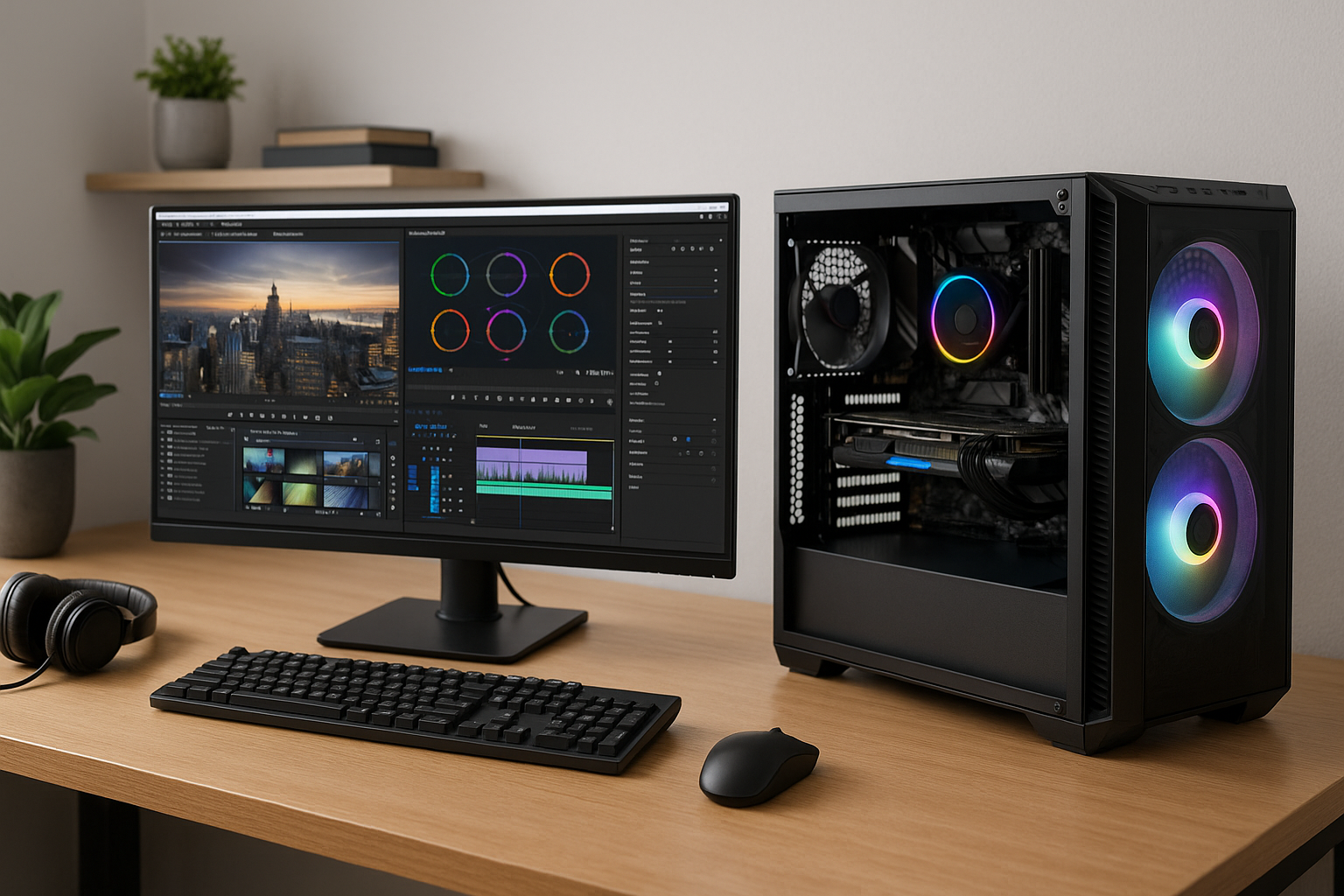If you’re into content creation — whether as a professional or a passionate hobbyist — having a computer that can handle video editing and graphic design smoothly is crucial. Unlike gaming, creative workloads require a balance of processing power, memory, and storage — and every bottleneck can waste time and hinder productivity.
In this guide, we’ll walk you through how to build a PC specifically optimized for video editing, graphic design, and creative software like Adobe Premiere Pro, After Effects, Photoshop, DaVinci Resolve, and more.
Define Your Creative Workflow
Before choosing components, you need to understand your actual needs. Ask yourself:
- Are you editing 1080p, 4K, or 8K videos?
- Do you work with motion graphics and rendering (e.g., After Effects, Blender)?
- Is your work multitask-heavy (editing + rendering + web + streaming)?
Answering these will guide decisions for your CPU, GPU, RAM, and storage.
Essential Components for Creative Work
Let’s break down the key hardware parts and what you should prioritize for a creator-focused build.
1. Processor (CPU) – The Heart of Editing
Video editing and design rely heavily on the CPU — especially for rendering, encoding, and multitasking.
Ideal Specs:
- 6 to 12 cores for smooth timeline editing and fast renders
- High clock speeds for faster previews and responsiveness
- Multithreading support (like Intel Hyper-Threading or AMD SMT)
Top CPU Picks:
- AMD Ryzen 7 5800X / Ryzen 9 5900X
- Intel Core i7-12700K / i9-12900K
- Apple Silicon (for Mac users) — but this article focuses on PC builds
2. Graphics Card (GPU) – Accelerated Rendering
A powerful GPU speeds up timeline playback, real-time effects, and rendering, especially in Adobe Premiere Pro, DaVinci Resolve, and 3D applications.
Look for:
- At least 8GB VRAM
- Support for CUDA (NVIDIA) or OpenCL (AMD)
- GPU-accelerated software compatibility
Recommended GPUs:
- NVIDIA RTX 3060 / 3070 / 4060 / 4070
- AMD Radeon RX 6700 XT / 6800
NVIDIA cards are often preferred in editing workflows due to wider support for CUDA acceleration.
3. RAM (Memory) – Multitasking Power
Creative work is RAM-hungry, especially when working with large files, multiple layers, or exporting high-resolution content.
Ideal RAM:
- 16GB minimum for 1080p editing
- 32GB or more for 4K+ workflows and professional design
- Dual-channel or quad-channel kits for better performance
RAM is one of the easiest upgrades later, but starting with at least 32GB is highly recommended for professionals.
4. Storage – Speed and Capacity
Fast storage is critical for loading files, caching previews, and exporting quickly.
Recommended setup:
- NVMe SSD (500GB–1TB): for operating system, apps, and active projects
- SATA SSD or HDD (1TB–4TB): for long-term storage, archives, and backups
Using multiple drives for separation (OS / projects / exports) improves speed and stability.
5. Motherboard – The Backbone
The motherboard doesn’t directly affect performance, but it must support your other components and future upgrades.
Key Features:
- Enough RAM slots (4 minimum)
- M.2 slots for NVMe SSDs
- Reliable VRM for power delivery
- Thunderbolt/USB-C, if you use external drives or tablets
Brands like ASUS ProArt, MSI Tomahawk, or Gigabyte Vision are great for creators.
6. Power Supply (PSU)
A stable and efficient PSU is important for handling high loads during rendering or GPU acceleration.
Specs:
- 650W–850W depending on GPU/CPU
- 80 PLUS Gold or better
- Reputable brands (Corsair, Seasonic, EVGA)
7. Case and Cooling
Content creation pushes your PC hard — so invest in good airflow and cooling.
Look for:
- A case with good airflow
- Support for liquid cooling or high-end air coolers
- Quiet fans (if you’re recording audio or streaming)
8. Monitor – Color Accuracy Matters
Your screen affects how your final work looks. Creators need more than just a basic display.
Choose:
- IPS panels with wide color gamut (sRGB or AdobeRGB)
- Color-calibrated monitors
- At least 1440p resolution; 4K for video professionals
Brands like Dell UltraSharp, BenQ, LG, and Eizo offer excellent displays for creators.
Optional (But Useful) Add-ons
- Drawing tablet (Wacom, Huion) for designers
- Color calibration tools (X-Rite, Datacolor)
- Dedicated audio interface if you do sound work
- High-speed card readers for photographers and videographers
Sample PC Build for Video Editing and Design (Mid-Range)
| Component | Example Model | Est. Price |
|---|---|---|
| CPU | AMD Ryzen 9 5900X | $350 |
| GPU | NVIDIA RTX 3060 Ti | $300 |
| RAM | 32GB DDR4 3600MHz | $90 |
| Storage | 1TB NVMe SSD + 2TB HDD | $130 |
| Motherboard | B550 ATX | $120 |
| PSU | 750W 80+ Gold | $90 |
| Case | Mid-Tower w/ airflow | $60 |
| Monitor | 27” IPS QHD (100% sRGB) | $250 |
| Total | ~$1,390 |
Prices vary by region and availability — always check for bundles or deals.
Software Optimization Tips
After you build the PC, optimize your creative workflow:
- Enable GPU acceleration in editing software
- Move cache folders to your NVMe SSD
- Use proxies for smoother editing of 4K+ footage
- Keep your drivers updated
- Calibrate your monitor for accurate color work
Final Thoughts: Build Smart for Creative Efficiency
Building a PC for creative work is about balance — combining CPU speed, GPU power, and fast memory and storage. Don’t just chase gaming benchmarks; instead, prioritize what matters for your tools and creative process.
With the right setup, you’ll enjoy:
- Faster rendering
- Smoother previews
- Efficient multitasking
- A better overall experience with creative software
Whether you’re editing videos, designing graphics, or animating 3D scenes, a well-planned PC build is one of the best investments you can make.
